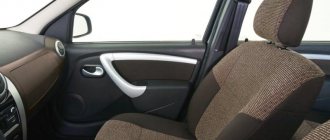What does the traffic regulations say?
Section 23 of the Traffic Regulations of the Russian Federation, Articles 23.1 – 23.5, is devoted to the rules for the transportation of goods. The main responsibilities of the driver of a passenger car, enshrined in these paragraphs:
- Overload is not allowed. The maximum load of the vehicle can be clarified in the PTS, in the column “Permitted maximum weight”. Exceeding this parameter will lead to suspension defects and body deformation.
- Before embarking on a flight, you must ensure that the cargo is secured securely. This responsibility is assigned to the driver (clause 23.2).
- When placing luggage, it is important that it does not reduce visibility (clause 23.3), does not affect vehicle control, does not affect the stability of the car and does not pollute the environment during transportation (for example, sand does not spill).
- Lighting devices should not be blocked. If this cannot be avoided, the driver will have to give a hand signal to another participant in the movement.
- If fatal problems arise during transportation, you will have to cancel the trip.
Legal aspect
The transportation of goods is regulated by the Road Traffic Rules (TRAF). We would like to remind you of a few key points. Baggage must not:
block your visibility;
complicate the process of driving a car;
worsen the stability of the “iron horse”;
block the headlights and registration number of the car;
create additional noise;
pollute the environment.
Transported items should not extend beyond the vehicle more than 1 m in front and 0.4 m on the sides (calculated based on the dimensions). If exceeded, use the special sign “Large cargo”.
If you are driving in poor visibility conditions, use:
on the front of the reflectors there is a white spectrum of light (or a lantern);
on the back are the same devices, but with a red glow.
It is prohibited to transport items exceeding the following parameters:
If you need to transport such a “large vehicle,” coordinate the route with the traffic police and obtain a special permit.
For violation, the traffic police inspector has the right to issue you a warning or fine.
If you have any difficulties with fasteners, contact a car service. You can find a suitable technical center on the aggregator website Uremont.com. Here the rating system helps to formulate an idea of the workshop in advance. An interactive map allows you to quickly find a place that is conveniently located. Filling out the application will take you no more than 10 minutes, and you will receive answers within 20 minutes (average times are indicated).
Rules for the transportation of oversized cargo
In addition to the traffic rules, instructions for transporting large items in passenger cars are contained in the following regulations:
- Government Decree No. 272 “On the rules for transporting goods by road”;
- Order of the Ministry of Transport No. 258 “On the procedure for issuing permits for the transportation of heavy and large-sized cargo”;
- Order of the Ministry of Transport No. 7 “On safety rules for the transportation of passengers and cargo.”
Main restrictions:
- Exceeding the permissible speed.
- Transportation in difficult weather conditions: snowfall, ice, poor visibility.
- Driving on the side of the road.
- Stopping outside parking lots and parking areas.
- Continue driving if malfunctions or breakdowns of the vehicle occur.
Permitted dimensions
According to clause 23.4 of the Traffic Regulations, a load whose dimensions protrude beyond the front and rear of the vehicle by more than 1 m and on the sides by more than 40 cm is considered large. All items that fit within the specified parameters are considered oversized and do not have any special recommendations for transportation.
Traffic regulations regarding luggage dimensions:
- by lenght. An object placed on a passenger car can protrude 1 m beyond its limits. If the luggage protrudes beyond the specified distance on only one side (front or rear), then it is still considered oversized;
- in width. The maximum protrusion of a regular load should not exceed 40 cm, all others are oversized. The measurement must be taken from the edge of the rear marker light. This means that the overhang from the side door will be slightly smaller;
- in height. There are no clear instructions regarding this parameter in clause 23.4, but according to clause 23.5, the maximum distance of the top point from the asphalt cannot exceed 4 meters. Moreover, if the item does not exceed the criteria for length and width, but its height is, for example, 3.85 m, then the designation “Large cargo” is not required.
How to tie things on the trunk of your car.
When you own a car, at some point, sooner or later, you may need to carry luggage on the roof of the car. This is the best place in the car to carry unusual bulky cargo and other things that cannot fit in the car. In this case, if you need to transport a rather large load that does not fit in the cabin or trunk, then the best place is the roof of your car.
At the moment, there are many smart and fashionable roof racks and other accessories for the roof of the car for convenient transportation. But they all cost a lot of money and are quite bulky to store at home. If you rarely need to carry luggage on the roof, then there is no point in purchasing such roof racks.
So for many who want to transport cargo on the roof of a car, the problem becomes how to safely transport cargo without a special trunk. Unfortunately, most drivers don't know how to do this. We offer you a life hack that will help you securely and independently secure bulky luggage on the roof of your car.
In order to securely secure cargo on the roof, ideally there should be something on the car so that the luggage can be tied down. For example, roof rails, which are found in many modern cars. Also, in order to safely tie the cargo on the roof of the car, you need to lay a cloth or blanket on it so that the luggage does not slide.
In addition, you will need a regular rope, with which you will tie your luggage, with which you can safely move no more than 50 km/h.
For example, it is very convenient to use nylon straps (ties), with which you can secure anything to the roof, from bicycles to pieces of furniture. Such belts will help you secure your luggage on the roof, regardless of whether your car is old or new.
If you secure your luggage correctly on the roof of the car, then even at high speed the cargo will not fly off the car. The main thing is the strength of the knots and the correct bundle of luggage. This will ensure that your roof luggage is stable and safe.
Here's what you need to secure any load on the roof of your car:
First of all, as we already said, you must have some kind of strong rope or nylon straps. If the ends of the rope or straps show signs of wear, you will need to cut them off with a sharp knife or scissors to make the fastener straight.
To prevent the ends of a synthetic rope or belt from fraying, you need to burn them with a lighter and press the melted end with a piece of cardboard. Never touch the melted end of a belt or rope with your fingers, as you may get seriously burned.
Attention! If the rope (or belt) is made of organic fibers, attempting to burn the ends with a lighter will cause the rope to catch fire.
In order to properly secure luggage on the roof, you must select at least 3 (and preferably 4) control points for securing the cargo. These attachment points will represent points of stability.
For example, in the photo you can see how you can mount a bicycle on the roof of a car by separately tying the steering wheel, frame and its rear part of the structure.
As you can see, to secure your bike to the roof you must place it with the wheels facing up. Then, one by one, begin to tighten the various elements of the bicycle with rope or belts. So first, secure the right handlebar of the bicycle. Then start tying the left handle. That is, in this way you secure the bicycle at two points of rigidity. Then secure the rear of the bike by tightening the strap securely.
Please note that you need to make several turns of a belt or rope around the bicycle handlebar, grabbing the bicycle frame directly. Please note that the turns must be made under tension to prevent the luggage tie from loosening while the car is moving. Also, after each turn of the belt, make a knot in it.
In principle, you can secure the load on the roof in many ways that are most convenient for you. The main thing to remember is that in order to securely attach luggage to the roof of the car, it must be secured to at least three points of support. Ideally, there should be four such points.
After you have secured all parts of the load, your task is to make a strong knot at the end of the rope, which should not under any circumstances come undone while the vehicle is moving.
To do this, before securing the end of the rope or belt, make a braid like the one in the photo.
Also, when transporting a bicycle, you can secure the rest of the rope or belt under the seat. Example in the photo.
Here's another example of how to secure a surfboard to the roof of a car. This method of mounting on the roof of a car is also suitable for transporting any other flat objects, such as a stepladder, bookshelves, picture frames, etc.
As with a bicycle, when transporting flat items on the roof of a car, place a cloth or blanket under the roof rails to prevent the cargo from sliding off the roof rack.
Next, you must thread the belt or rope as shown in the photo.
Then thread the belt through the other side as well. As a result, you will make a reliable load tie. If you are using a belt with factory clips, then positioning the belt as in the photo above will easily secure the ends together.
If you use rope, you need to make a secure knot.
To securely fasten flat elements to the roof of the car, you need to make several turns of the belt or rope around the luggage on each side, threading the fastening element several times through the luggage rails on the roof of the car.
Pay attention to the photo. This type of flat roof luggage hitch is secured at four support points, which ensures the safety and security of the tied luggage on the roof of the car.
The only thing that can move a flat load is if it sticks out strongly above the windshield. Then, when the car is moving at speed, aerodynamic air resistance can weaken your cargo hitch or lift it up.
Note! Always check how securely you have secured your luggage to the roof of your car!
When you have secured any luggage with straps or rope, always test how secure the hitch is. To do this, move the load in different directions, swinging it in one direction or the other. Try lifting your luggage or moving it away from you. If your luggage is moving, you may not have tightened the straps or rope tightly enough, which could cause your luggage to fall off the roof while your car is driving on the highway.
Remember that if you don't tighten the straps tightly, strong winds when the car is moving can lift your luggage up.
If you have checked that the load on the roof of the car is secured securely enough, then you can hit the road. But again, remember that the vehicle should move at low speed. At high speed, you not only risk losing all the luggage placed on the roof, but also put the lives of other road users in danger. Be reasonable and responsible.
Related article: Roof construction from corrugated sheets diagram
Also, don't be discouraged if your car doesn't have roof rails. All the same, if necessary, you can safely transport luggage on the roof that does not fit in the trunk or interior of the car. To do this, lay a blanket over the entire roof (or thick fabric). Next, place the load on the roof and secure it with straps, threading it through the interior of the car. Ideally, in this case, the windows in the doors will be open.
Pay attention to the hitch if there are no roof rails. It should be as durable as possible.
In addition, if your luggage is too high, then be careful, as such a load will create a lot of windage in your car, which will lead to the fact that the car may become unstable on the road and eventually roll over on the road.
Transportation of oversized cargo
According to the traffic rules established for the transportation of oversized items:
- You cannot transport cargo that disrupts the stability of the vehicle.
- Be sure to use the “Large Load” sign, as well as signal lights or reflectors at night. There is a white light in front and a red one in the back.
- If possible, refrain from transporting oversized items in difficult weather conditions, poor visibility and at night.
Dimensions and transportation rules
Oversized cargo is any object that protrudes beyond the vehicle in length from 1 to 2 m from the bumper, in width - 40 cm from the rear marker light.
Basic instructions for transporting such luggage:
- use a square-shaped sign with diagonally located alternating red and white stripes. The sign is placed on the most protruding part;
- in case of poor visibility, secure the lights: white in front of the car, red in the back;
- if the height is exceeded 4 m, permission must be obtained from local authorities. A warning sign is required to be placed in this case;
- when transporting dangerous goods, it is necessary to agree on the route of movement with the traffic police and not deviate from it;
- if the protrusion from the rear of the car exceeds 2 m, then such a trip will also require permission from the municipality and the traffic police.
Manufacturers of car luggage racks – value for money
Today, the segment of high-quality roof racks is represented by 5-7 foreign manufacturers and 2-3 domestic companies. It all depends solely on your budget, needs and needs.
Related article: Do-it-yourself installation of a gable roof rafter system
You should not trust cheap analogues and unknown manufacturers. The road is an increased danger and it is necessary to carry loads on the roof with enhanced safety precautions.
Mounting a bicycle on a car trunk must be prepared for increased loads. The autobox must have additional locks and measures to secure your cargo, such as clips or locking buttons.
It is worth remembering that exceeding the permissible load or approaching the maximum weight of the vehicle carries a risk of damaging the roof and significantly reducing the aerodynamics, appearance and cost of the car.
Before purchasing, study video reviews, of which there are a huge number today. It is worth noting that manufacturers specializing in car racks produce and modernize their model range every season. If you need modern solutions, choose new items; if you want to save money, buy old, proven variations.
Rules for transportation on the roof of a car
Before placing luggage on the roof of a passenger car, you must read the manufacturer's recommendations. The maximum permissible weight must not be exceeded.
Average indicators:
- For a domestically produced passenger car – 40-60 kg.
- Foreign manufacturer - 60-90 kg.
When using a roof rack on a car, you should follow the general instructions for transporting large and oversized cargo. Placement and transportation rules:
- do not exceed the established dimensions (40 and 100 cm);
- if the specified dimensions are exceeded, use a warning sign;
- do not block the driver’s view;
- place luggage in the middle to avoid shifting the vehicle’s center of gravity;
- If a malfunction is detected while driving, immediately stop the car and repair the breakdown;
- securely secure the cargo to the trunk. All items that fall out or doors that open must be carefully secured or removed;
- tie objects tightly with ropes or special tapes, without gaps;
- observe the speed limit: for the city - 60 km/h, for the highway - 90 km/h;
- check the reliability of the fastenings every hour of driving.
Types of luggage racks and features of their design
The trunk consists of transverse bars that are fixed to the roof of the car. These products are classified into several types depending on design features and types of fastening. When choosing, you need to pay attention to the credibility of the manufacturer, the presence of positive reviews and the suitability of the fixation system for a specific car. The numerous advantages of a car roof rack have made this structural element one of the most popular.
Open type
A universal product that can be installed on any car model. This type of trunk is designed for transporting various items. Due to the metal crossbars and crossbars, the load is securely fastened and held on the roof. Additional fastening elements guarantee stability and increased fixation strength. A distinctive feature of the device is its affordable price.
The disadvantages of attaching an open roof rack include poor aerodynamic qualities, which negatively affects fuel consumption, and the lack of protection of the transported cargo from precipitation. The reliability of securing cargo is increased by using a net to secure cargo on the trunk.
Car luggage box
Available in two variations: hard and soft. This device protects the roof and transported items from precipitation and dirt. The rigid design of the trunk looks like a box made of plastic or carbon fiber. The latter option is more durable, but its cost is higher. Products differ in volume, material and fastening system. When choosing, you need to focus on the desired result and technical characteristics.
Trunk locks protect transported items from attacks by intruders, even in unguarded parking lots. When moving, excellent aerodynamic qualities are provided, which reduces drag during high-speed driving and reduces the load on the engine. The average cost is 10,000 rubles.
Specialized racks
The trunk is designed for transporting sports equipment and bicycles. The system consists of a combination of fasteners. The product is suitable for people who lead an active lifestyle and prefer cycling in nature. The advantage of such a trunk is its mobility, because it can be secured immediately before use and then safely dismantled.
The disadvantages include an insignificant level of practicality, since the user has the opportunity to transport only a certain type of product (bicycles, boats, sports equipment). Despite the simplicity of the design, sometimes difficulties arise with its installation.
Universal trunk
This type of luggage rack combines the features of other varieties. It is suitable for securing objects of various sizes, easy to install and dismantle if necessary. This universal product is one of the most popular due to its mobility and practicality.
Expeditionary basket-type luggage rack
In appearance it resembles a basket with special zones. Here you can place various items, such as a bump stop, a spare tire, a flashlight, and tools. This is an excellent option for tourists, hunters and fishermen. In addition, the product protects the upper body of the car from mechanical damage while driving. The expeditionary type rack mount has a number of distinctive nuances and features.
Transportation in a light trailer
Any trailer is a vehicle that does not have its own engine and is used together with another vehicle to transport goods. Since the trailer is a vehicle, the traffic rules in relation to it must be followed:
- For fastening, a rigid tow bar is used, equipped with electrical wiring and a plug socket.
- The trailer itself must be equipped with light signals: turn signals, brake lights, and clearance lights.
- It is prohibited to exceed the maximum permissible weight of a loaded trailer. It differs for each vehicle category; for “B” this parameter is 750 kg. The weight of the trailer must not exceed the weight of the passenger car.
The order of movement with a trailer, as well as ways to designate the load:
- avoid sudden braking, since the additional mass increases the braking distance;
- to keep distance;
- reduce speed before turning;
- it is advisable to exclude maneuvering in traffic and reversing with poor visibility;
- During the trip, carry the registration documents for the trailer with you. They must be presented to the traffic police inspector upon request. For individuals, having a diagnostic card is not necessary;
- observe the speed limit, it is reduced by 20 km/h: within the city - 40 km/h, outside the city - 70 km/h, on highways - 90 km/h;
- if the transported item is recognized as oversized, use a sign and reflective elements or lights;
- To transport oversized luggage using a trailer, a passenger car must be equipped with rear-view mirrors on extended brackets.
International shipping
If you need to travel by car outside the country, you must familiarize yourself with the rules of the Customs Union in advance. Here is the exact list of items permitted for export. It is important that all of them must be for personal use and not for profit.
The rules for transporting goods by car depend on the current traffic legislation adopted in a particular country.
| Did not find an answer to your question? Call a lawyer! Moscow: +7 (499) 110-89-42 St. Petersburg: +7 (812) 385-56-34 Russia: +7 (499) 755-96-84 |
Traffic regulations allow the transportation of both oversized and oversized cargo in a passenger car. For your own safety and taking into account the interests of other road users, you must use special signage, adhere to the speed limit, and avoid traveling in difficult weather conditions.










